
ap bio unit 2 review
Cell Organelles, Membranes, and Transport
Cell Organelles and Their Functions
two major types of cells:
prokaryotic: simpler in structure; found in bacterial organisms
eukaryotic: contain membrane-bound organelles; more complex; found in animals, plants, fungi, and protists
all cells (prokaryotic and eukaryotic) have the following: genetic material, ribosomes, cytosol, and a plasma membrane
the genetic material in prokaryotes is circular and stored in the center of the cell called the nucleoid region
plasmids: small circular pieces of genetic material stored outside of the chromosome; often found in some forms of bacteria
genetic material in eukaryotes is linear and stored in a membrane-bound nucleus
ribosomes: functions in protein synthesis; found in prokaryotic and eukaryotic cells; made of proteins and ribosomal RNA (rRNA)
sizes of the large and small subunits of ribosomes vary in eukaryotic and prokaryotic cells
during translation: ribosomes assemble amino acids into polypeptide chains according to the mRNA sequence
there are free ribosomes in the cytosol and organelle-bound ribosomes on the membrane of the rough endoplasmic reticulum
endoplasmic reticulum: formed of two parts (smooth ER and rough ER)
rough ER: covered with ribosomes; functions in proteins synthesis
smooth ER: does not contain ribosomes; functions in lipid synthesis and detoxification of harmful substances in the cell
golgi complex (golgi body/apparatus): a stack of flattened membrane sacs (cisternae); functions in controlling the modification and packaging of proteins for transport
lumen: interior of cisternae; contains necessary enzymes for the golgi complex to function
proteins made on the free ribosomes of the rough ER are sent to the golgi body to be modified and packed into vesicles for transport throughout the cell
vesicles: structure within or outside a cell, consisting of liquid or cytoplasm enclosed by a lipid bilayer
lysosomes: membrane-bound sacs containing hydrolytic enzymes that are used in various functions including digestion of macromolecules, breaking down of worn-out cellular parts, apoptosis, or destroying bacteria in the cell
hydrolytic enzymes: break down protein, lipids, nucleic acids, carbohydrate, and fat molecules into their simplest units
vacuoles: membrane-bound sac that functions in the storage of food or water for the cell, water regulation, or waste storage (until it can be eliminated)
plant vacuole: large central vacuole that helps regulate the water balance of cell
well-hydrated plant cells will have proper turgor pressure, which is maintained by the vacuole in the center of the plant cell
turgor pressure: provides structural integrity to each cell and to the tissue as a whole; pushes the plasma membrane against the cell wall and causes in-plane mechanical tension within the cell wall
animal vacuole: generally small and help sequester waste products
mitochondria: produces energy (ATP) for the cell; contains a double membrane (smooth outer membrane and folded inner membrane)
the folded inner membrane allows for increased surface area, which increases the efficiency of ATP production during cellular respiration
the double membrane allows for mitochondria to form proton (H+) gradients which are necessary for ATP production
matrix: center of the mitochondria; fluid containing enzymes; the location where the krebs cycle (citric acid cycle) occurs
mitochondria also contain their own ribosomes and mitochondrial DNA (mtDNA)\

chloroplasts: found in plants and algae; carry out photosynthesis; double membrane organelle with smooth outer membrane and structures inside
thylakoids: pancake shaped membraneous sacs stacked into structures; functions in light-dependent reaction
grana: the structures thylakoids are stacked into
stroma: liquid in chloraplast surrounding the grana; enzymes in stroma function in light-independent reactions
contain their own dna (cpDNA)
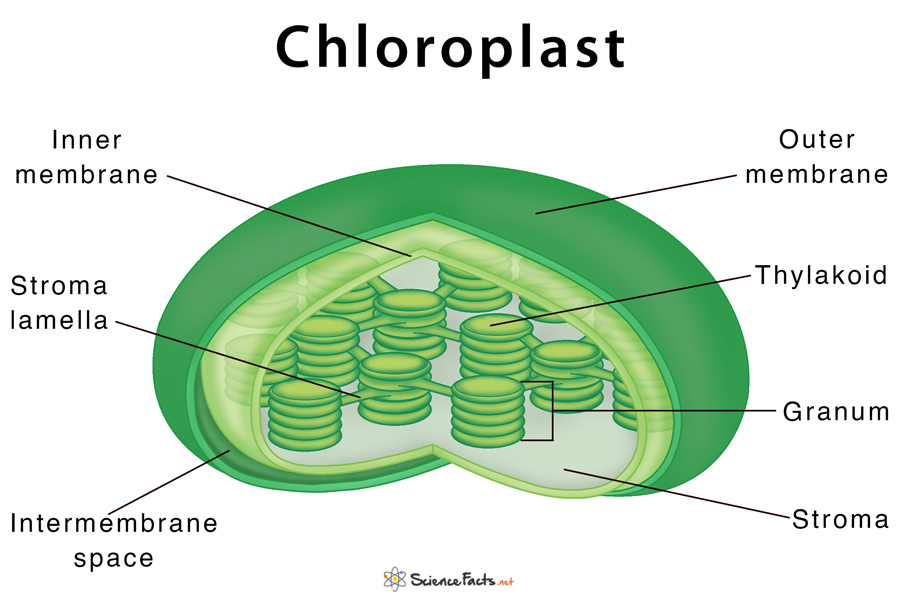
centrosome: found in animal cells; helps microtubules assemble into spindle fibers (used in cell division)
defects in centrosome cause dysregulation of cell cycle (and causes some cancer)
amyloplasts: starch molecule that store excess glucose produced during photosynthesis; commonly found in starchy root vegetables (ex. potatoes)
several structures are found in plant and animal cells:
peroxisome: helps oxidize molecules and break down toxins in cells
nucleolus: not membrane bound organelle; region in the nucleus where ribosomes are assembled
cytoskeleton: fibers that help give cells their shape and move items in cell
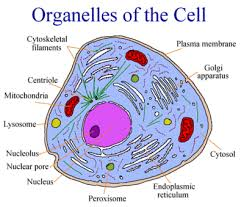
Endosymbiosis Hypothesis
endosymbiosis hypothesis: states that membrane-bound organelles (mitochondria and chloroplasts) were once free-living prokaryotes that were absorbed by larger prokaryotes
the prokaryotes became interdependent of each other and the larger prokaryotes evolved into membrane bound organelles
reasons for this theory:
mitochondria and chloroplasts have their own DNA (circular like prokaryotic DNA)
mitochondria and chloroplasts have their own ribosomes (similar in structure to prokaryotic ribosomes)
mitochondria and chloroplasts are produced by binary fission (similar to how bacteria reproduce)
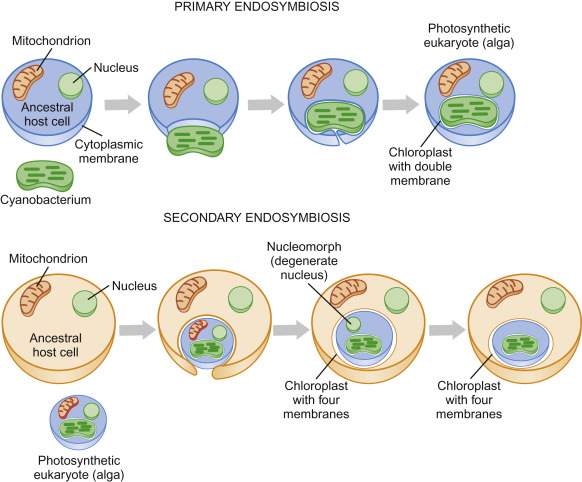
Advantages of Compartmentalization
membrane-bound organelles form compartments to increase their efficiency
compartmentalization: allows cells to separate enzymes involved in different metabolic processes
this reduces the risk of cross-reacting, which would decrease efficiency of the cellular processes
The Importance of Surface Area to Volume Ratios
many eukaryotic organelles (ex. mitochondria) have folds in their membranes to increase surface area
prokaryotes can fold their single membranes to also increase surface area
the larger the SA:V ratio, the more efficient the cell is
as radius increases, the ratio decreases
larger cells have a lower SA:V ratio, making them less efficient in certain functions
Structure of Plasma Membranes
plasma membranes are selectively permeable (some materials can cross and others cannot)
selective permeability allows the cell to maintain its internal environment
plasma membranes are made of a phospholipid bilayer
phospholipids have a hydrophilic phosphate head and two hydrophobic tails
tails orient themselves away from internal (aqueous) environment
phospholipid bilayer contains glycoproteins, glycolipids, and steroids
these molecules can move throughout the bilayer and allow the cell to adapt adn respond to changing environmental conditions
proteins (in membrane): used to transport materials, participate in cell signaling processes, anchor the cell in place, and catalyze chemical reactions
glycoproteins and glycolipids: used in cell recognition
steroids: adjust membrane fluidity in response to changing environmental conditions and needs of the cell
fluidity of molecules in plasma membrane gives it the term “fluid mosaic model”
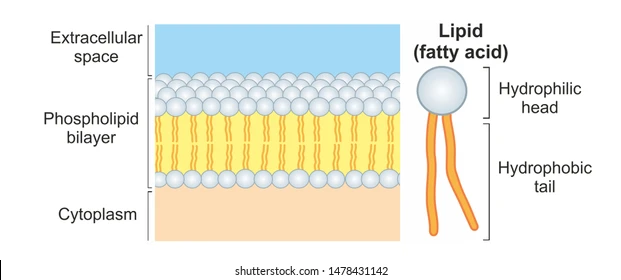
Crossing (and Not Crossing) Plasma Membrane
phospholipid bilayer makes cell membrane selectively permeable
small hydrophobic molecules (ex. oxygen, carbon dioxide, and nitrogen) can move between phospholipids and in/out of the cell
larger polar molecules and ions cannot pass through as easily without help
large polar and charged molecules must use membrane channels or transport proteins to enter/exit cell
small polar molecules (ex. H2O) can pass in small quantities; larger amounts also must be assisted
aquaporins: special proteins that allow for the movement of (most) water in/out of cells
Passive Transport
passive transport: movement of molecules in/out of cell without energy required; molecules move from areas of high concentration to areas of low concentration (moving “down” concentration gradient)
diffusion: movement of molecules down concentration gradient without energy required
osmosis: diffusion of water molecules down a gradient and across a membrane
facilitated diffusion: process of passive transport with use of membrane protein; used for polar/charged molecules
aquaporins are an example of membrane proteins (only used for water)
channel proteins: can allow the passive transport of ions (ex. Ca+2 or Cl-1) down the concentration gradient
rate of facilitated diffusion is limited by the number of membrane proteins available
Active Transport
active transport: movement of molecules from areas of low concentration to high concentration; movement of molecules “against” concentration gradient requires the input of energy
Na+/K+ pump: prime example of active transport
membrane protein requires the input of ATP to pump Na+ ions from lower concentration to higher concentration outside the cell
membrane protein pumps K+ ions from areas of lower concentration to higher concentration inside the cell
for every 3 Na+ ions pumped outside cell, 2 K+ ions are pumped into cell
results in higher concentration of positive ions outside of cell and helps cell maintain membrane potential
endocytosis and exocytosis are also forms of active transport (both require input of energy)
endocytosis: used by cell to take in water and macromolecules with vesicles formed from plasma membrane
exocytosis: vesicles (with molecules) are merged with cell membrane and molecules in vesicles are expelled from cell
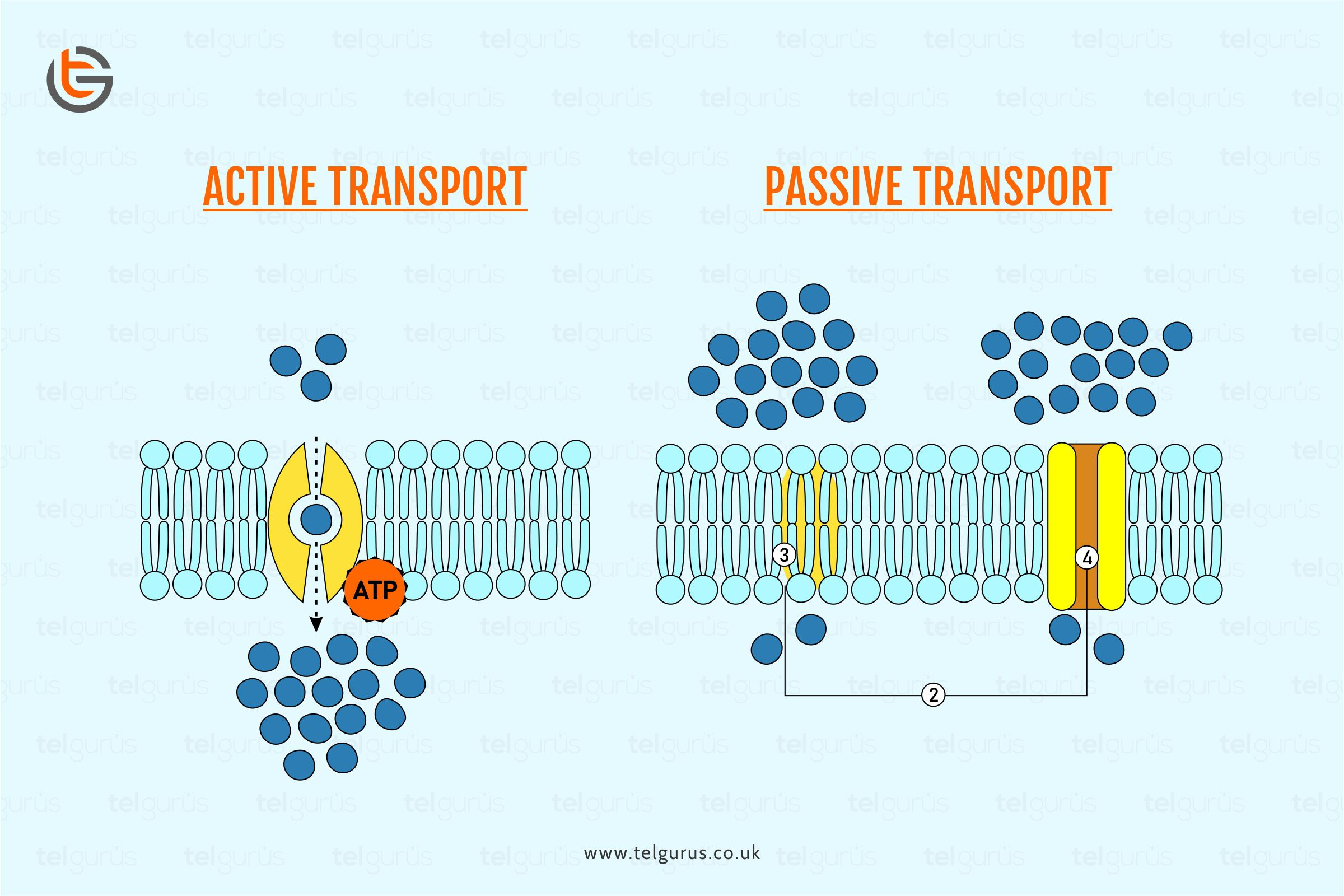
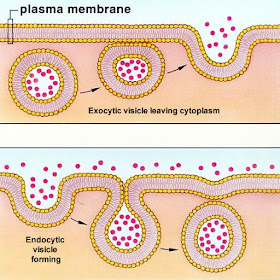
Movement of Water in Cells
Water Potential
hypotonic: lower concentration of solute outside than inside cell; higher water potential
cell swells and bursts
hypertonic: higher concentration of solute outside than inside cell; lower water potential
cell shrinks and shrivels
isotonic: equal concentration of solute inside and outside cell
cell pressure is maintained
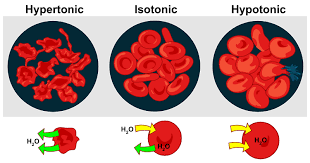
water potential: the potential energy of water in a solution; the ability of water to do work
the more water there is in a solution, the higher the water potential
water flows down concentration gradients (higher concentration to lower concentration)
Calculating Water Potential
solute potential (Ψs): water potential due to solute concentration
Ψs depends on how many particles in the solute form the solution and the temp. of the solution
Ψs = -iCRT
i: ionization constant; function of how many particles or ions will form the solution in a given solute
covalent compounds: i = 1 (ions don’t separate)
ionic compounds: i depends on how many ions form in the solution (ex. NaCl forms 2 ions (Na+ and Cl-) so i = 2)
C: concentration of solute in solution; as concentration increases, solute potential decreases
solutes with more solute (higher solute concentration) will have lower water potential (if all other variables are equal)
R: pressure constant; R = 0.0831 L-bars/mol-K
T: temperature of solution; only in Kelvin
pressure potential (Ψp): water potential due to pressure on system
most biological systems are open to equilibrium in their environments which eliminates pressure in the equation and it becomes: Ψ = Ψs
when solution is open to atmosphere, Ψp is zero
Osmolarity and Regulation
osmolarity: total concentration of solutes in solution
living organisms need to closely regulate internal solute concentration and water potential (to far away from proper conditions could lead to death)
contractile vacuole: specialized organelle used to store excess water until it is pumped out of the cell; allows cells to maintain internal solute concentration
ap bio unit 2 review
Cell Organelles, Membranes, and Transport
Cell Organelles and Their Functions
two major types of cells:
prokaryotic: simpler in structure; found in bacterial organisms
eukaryotic: contain membrane-bound organelles; more complex; found in animals, plants, fungi, and protists
all cells (prokaryotic and eukaryotic) have the following: genetic material, ribosomes, cytosol, and a plasma membrane
the genetic material in prokaryotes is circular and stored in the center of the cell called the nucleoid region
plasmids: small circular pieces of genetic material stored outside of the chromosome; often found in some forms of bacteria
genetic material in eukaryotes is linear and stored in a membrane-bound nucleus
ribosomes: functions in protein synthesis; found in prokaryotic and eukaryotic cells; made of proteins and ribosomal RNA (rRNA)
sizes of the large and small subunits of ribosomes vary in eukaryotic and prokaryotic cells
during translation: ribosomes assemble amino acids into polypeptide chains according to the mRNA sequence
there are free ribosomes in the cytosol and organelle-bound ribosomes on the membrane of the rough endoplasmic reticulum
endoplasmic reticulum: formed of two parts (smooth ER and rough ER)
rough ER: covered with ribosomes; functions in proteins synthesis
smooth ER: does not contain ribosomes; functions in lipid synthesis and detoxification of harmful substances in the cell
golgi complex (golgi body/apparatus): a stack of flattened membrane sacs (cisternae); functions in controlling the modification and packaging of proteins for transport
lumen: interior of cisternae; contains necessary enzymes for the golgi complex to function
proteins made on the free ribosomes of the rough ER are sent to the golgi body to be modified and packed into vesicles for transport throughout the cell
vesicles: structure within or outside a cell, consisting of liquid or cytoplasm enclosed by a lipid bilayer
lysosomes: membrane-bound sacs containing hydrolytic enzymes that are used in various functions including digestion of macromolecules, breaking down of worn-out cellular parts, apoptosis, or destroying bacteria in the cell
hydrolytic enzymes: break down protein, lipids, nucleic acids, carbohydrate, and fat molecules into their simplest units
vacuoles: membrane-bound sac that functions in the storage of food or water for the cell, water regulation, or waste storage (until it can be eliminated)
plant vacuole: large central vacuole that helps regulate the water balance of cell
well-hydrated plant cells will have proper turgor pressure, which is maintained by the vacuole in the center of the plant cell
turgor pressure: provides structural integrity to each cell and to the tissue as a whole; pushes the plasma membrane against the cell wall and causes in-plane mechanical tension within the cell wall
animal vacuole: generally small and help sequester waste products
mitochondria: produces energy (ATP) for the cell; contains a double membrane (smooth outer membrane and folded inner membrane)
the folded inner membrane allows for increased surface area, which increases the efficiency of ATP production during cellular respiration
the double membrane allows for mitochondria to form proton (H+) gradients which are necessary for ATP production
matrix: center of the mitochondria; fluid containing enzymes; the location where the krebs cycle (citric acid cycle) occurs
mitochondria also contain their own ribosomes and mitochondrial DNA (mtDNA)\

chloroplasts: found in plants and algae; carry out photosynthesis; double membrane organelle with smooth outer membrane and structures inside
thylakoids: pancake shaped membraneous sacs stacked into structures; functions in light-dependent reaction
grana: the structures thylakoids are stacked into
stroma: liquid in chloraplast surrounding the grana; enzymes in stroma function in light-independent reactions
contain their own dna (cpDNA)

centrosome: found in animal cells; helps microtubules assemble into spindle fibers (used in cell division)
defects in centrosome cause dysregulation of cell cycle (and causes some cancer)
amyloplasts: starch molecule that store excess glucose produced during photosynthesis; commonly found in starchy root vegetables (ex. potatoes)
several structures are found in plant and animal cells:
peroxisome: helps oxidize molecules and break down toxins in cells
nucleolus: not membrane bound organelle; region in the nucleus where ribosomes are assembled
cytoskeleton: fibers that help give cells their shape and move items in cell

Endosymbiosis Hypothesis
endosymbiosis hypothesis: states that membrane-bound organelles (mitochondria and chloroplasts) were once free-living prokaryotes that were absorbed by larger prokaryotes
the prokaryotes became interdependent of each other and the larger prokaryotes evolved into membrane bound organelles
reasons for this theory:
mitochondria and chloroplasts have their own DNA (circular like prokaryotic DNA)
mitochondria and chloroplasts have their own ribosomes (similar in structure to prokaryotic ribosomes)
mitochondria and chloroplasts are produced by binary fission (similar to how bacteria reproduce)

Advantages of Compartmentalization
membrane-bound organelles form compartments to increase their efficiency
compartmentalization: allows cells to separate enzymes involved in different metabolic processes
this reduces the risk of cross-reacting, which would decrease efficiency of the cellular processes
The Importance of Surface Area to Volume Ratios
many eukaryotic organelles (ex. mitochondria) have folds in their membranes to increase surface area
prokaryotes can fold their single membranes to also increase surface area
the larger the SA:V ratio, the more efficient the cell is
as radius increases, the ratio decreases
larger cells have a lower SA:V ratio, making them less efficient in certain functions
Structure of Plasma Membranes
plasma membranes are selectively permeable (some materials can cross and others cannot)
selective permeability allows the cell to maintain its internal environment
plasma membranes are made of a phospholipid bilayer
phospholipids have a hydrophilic phosphate head and two hydrophobic tails
tails orient themselves away from internal (aqueous) environment
phospholipid bilayer contains glycoproteins, glycolipids, and steroids
these molecules can move throughout the bilayer and allow the cell to adapt adn respond to changing environmental conditions
proteins (in membrane): used to transport materials, participate in cell signaling processes, anchor the cell in place, and catalyze chemical reactions
glycoproteins and glycolipids: used in cell recognition
steroids: adjust membrane fluidity in response to changing environmental conditions and needs of the cell
fluidity of molecules in plasma membrane gives it the term “fluid mosaic model”

Crossing (and Not Crossing) Plasma Membrane
phospholipid bilayer makes cell membrane selectively permeable
small hydrophobic molecules (ex. oxygen, carbon dioxide, and nitrogen) can move between phospholipids and in/out of the cell
larger polar molecules and ions cannot pass through as easily without help
large polar and charged molecules must use membrane channels or transport proteins to enter/exit cell
small polar molecules (ex. H2O) can pass in small quantities; larger amounts also must be assisted
aquaporins: special proteins that allow for the movement of (most) water in/out of cells
Passive Transport
passive transport: movement of molecules in/out of cell without energy required; molecules move from areas of high concentration to areas of low concentration (moving “down” concentration gradient)
diffusion: movement of molecules down concentration gradient without energy required
osmosis: diffusion of water molecules down a gradient and across a membrane
facilitated diffusion: process of passive transport with use of membrane protein; used for polar/charged molecules
aquaporins are an example of membrane proteins (only used for water)
channel proteins: can allow the passive transport of ions (ex. Ca+2 or Cl-1) down the concentration gradient
rate of facilitated diffusion is limited by the number of membrane proteins available
Active Transport
active transport: movement of molecules from areas of low concentration to high concentration; movement of molecules “against” concentration gradient requires the input of energy
Na+/K+ pump: prime example of active transport
membrane protein requires the input of ATP to pump Na+ ions from lower concentration to higher concentration outside the cell
membrane protein pumps K+ ions from areas of lower concentration to higher concentration inside the cell
for every 3 Na+ ions pumped outside cell, 2 K+ ions are pumped into cell
results in higher concentration of positive ions outside of cell and helps cell maintain membrane potential
endocytosis and exocytosis are also forms of active transport (both require input of energy)
endocytosis: used by cell to take in water and macromolecules with vesicles formed from plasma membrane
exocytosis: vesicles (with molecules) are merged with cell membrane and molecules in vesicles are expelled from cell


Movement of Water in Cells
Water Potential
hypotonic: lower concentration of solute outside than inside cell; higher water potential
cell swells and bursts
hypertonic: higher concentration of solute outside than inside cell; lower water potential
cell shrinks and shrivels
isotonic: equal concentration of solute inside and outside cell
cell pressure is maintained

water potential: the potential energy of water in a solution; the ability of water to do work
the more water there is in a solution, the higher the water potential
water flows down concentration gradients (higher concentration to lower concentration)
Calculating Water Potential
solute potential (Ψs): water potential due to solute concentration
Ψs depends on how many particles in the solute form the solution and the temp. of the solution
Ψs = -iCRT
i: ionization constant; function of how many particles or ions will form the solution in a given solute
covalent compounds: i = 1 (ions don’t separate)
ionic compounds: i depends on how many ions form in the solution (ex. NaCl forms 2 ions (Na+ and Cl-) so i = 2)
C: concentration of solute in solution; as concentration increases, solute potential decreases
solutes with more solute (higher solute concentration) will have lower water potential (if all other variables are equal)
R: pressure constant; R = 0.0831 L-bars/mol-K
T: temperature of solution; only in Kelvin
pressure potential (Ψp): water potential due to pressure on system
most biological systems are open to equilibrium in their environments which eliminates pressure in the equation and it becomes: Ψ = Ψs
when solution is open to atmosphere, Ψp is zero
Osmolarity and Regulation
osmolarity: total concentration of solutes in solution
living organisms need to closely regulate internal solute concentration and water potential (to far away from proper conditions could lead to death)
contractile vacuole: specialized organelle used to store excess water until it is pumped out of the cell; allows cells to maintain internal solute concentration
 Knowt
Knowt
